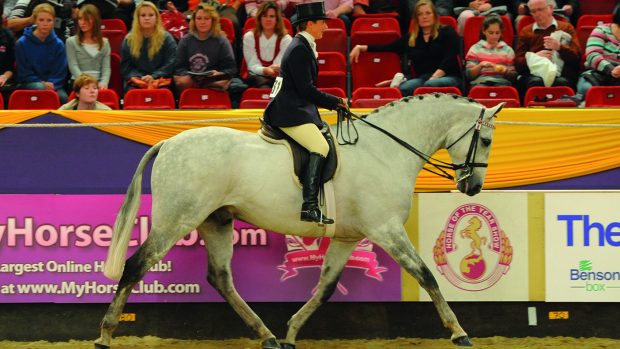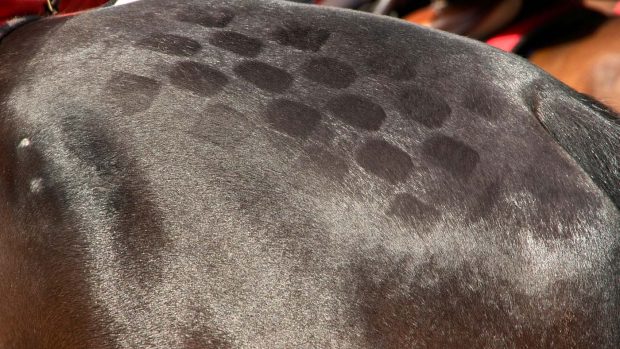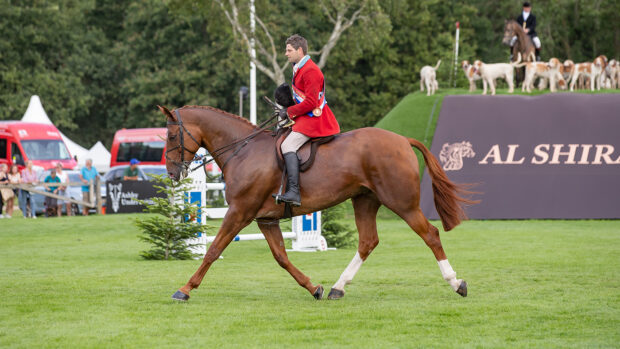With classes for ponies ranging from 122cm to 158cm, the show hunter pony is the ideal mount for a young rider of any age. The hunter pony is also the perfect choice for those looking for a diverse all-rounder with potential to succeed over fences and even outside of the show ring.
But if you have a quality show hunter pony, how can you present him for the ring and what exactly are eagle-eyed judges looking for?
What is a show hunter pony?
Just like show hunters a show hunter pony (SHP) should possess qualities that are recognised in the hunting field. They should be a scaled down middleweight hunter and have the same quality and good manners, while also having plenty of bone and substance.
Height divisions
Under British Show Pony Society (BSPS) rules show hunter pony classes are divided into height sections and each class has a rider age limit.
In the lead-rein pony of hunter type and first ridden classes – ponies must not exceed 122cm.
The next four individual classes run 122cm, 133cm, 143cm and 153cm sections.
There is also a class for intermediates of show hunter type. Animals must exceed 148cm but not exceed 158cm.
Some shows hold mixed height hunter pony classes where all the heights will be judged together.
“Within the SHP classes you’ll see that some are of a more lightweight type, while others will lean towards the heavyweight type,” says pony judge Robert Parker-Jones.
“In these classes exhibits should possess pony character. Too many carry too much condition, exhibitors feel that they should be beefed up to make them look more true to type. If they don’t have enough limb they can look top heavy and unbalanced.”
BSPS star judge Fiona Dymond agrees: “One thing I can’t stand is ponies with lots of topline to disguise a lack of timber.”
Tack and turnout
Show hunter ponies should be shown trimmed with mane plaited.
“The turnout of the SHP is similar to show hunters,” says Robert. “There is a tendency to have far too many tiny plaits with the impression that it improves the front. Tails should be pulled and cut to a length that when carried is approximately five or six inches below the point of the hock. Quarter marking and sharks teeth are often seen, but nothing too fancy for my liking.”
The tack is also similar to that of a show hunter horse.
“Both saddles and bridles should be chosen so that they show off a pony’s best points,” says Robert. “So often saddles can spoil a good front if incorrectly fitted and ponies heads spoilt due to incorrectly fitted or inappropriate bridles.”
Robert stated that the turnout of the rider should be understated.
“I like to see well-fitting, subtle tweed jackets that come down and just touch the back of the saddle, and sleeves that cover the shirt cuff,” he says. “Recent trends where large expanses of canary jodhpurs are revealed is unattractive and attracts the wrong type of attention.”
Show hunter ponies should wear plain leather browbands, too.
“Avoid too much bling,” adds Fiona. “Turnout should be smart and workmanlike. Avoid pink check jackets, sparkly hats, diamantes on ties and brass top bandmaster sticks. Opt for a smart green or brown based tweed, a more subtle tie and not too large a hair bow.”
Way of going
“I like to see a free, active walk covering the ground,” states Robert. “The trot should show a freedom of movement from the shoulder. Too many competitors trot far too fast and this is not attractive to watch. The canter should cover the ground and not be too slow or too collected.”
Robert added that when asked to gallop, riders should prepare their animals to lower the stride and increase speed gradually.
“I don’t want to see 0 to 60mph in three seconds. Transitions and rein changes should also be smooth and effortless.”
Unlike show hunters, the judge does not ride SHPs and competitors must perform an individual show.
“This may sound obvious but if you’re given a set show you must follow it to the letter,” says Fiona. “If you’re asked to finish at the banner, for example, then make sure you do so. It is surprising how many competitors don’t fully watch those who go before them and end up making unnecessary and costly mistakes.”
Riders should…
- “Ride on the outside track, find a space and focus on the pony’s way of going,” says Robert.
- “Find a space and keep out on the go round,” advises Fiona. “You don’t need to be running the judge down to get noticed. If you are going well it won’t go unnoticed.”
- “If galloping all together or in fours, find a space and extend and pull up gradually in front of the judge.”
- Be polite to judges, stewards and other exhibitors.
- “Even when you’re disappointed with your result, raise a smile and say ‘thank you’,” says Robert.
- “Plan an individual performance that demonstrates all paces, especially the walk and gallop.”
Riders shouldn’t…
- Forget to gallop. “The rule book states the gallop is an essential part of a SHP performance so make sure you do it,” says Fiona. “It shouldn’t be a mad scramble though — ease in and out of a few good strides.”
- “Ride a small circle so that you pass the judge more often than others in the class,” says Robert.
- “Try and reinvent traditional turnout and dress in an attempt to get noticed.”
- “If second placed animals are eligible for championships, make sure you’re present.”
- Apply too much product applied to ponies which spoil them, rather than enhances, and gets on judges’ clothes when presenting rosettes and sashes.
- Blacken hooves with white legs look completely false and unnatural.
- Wear over tailored jackets that are too short.
- Ride a stilted walk with ponies behind the vertical.
Continued below…
Like this? You might also enjoy reading these:
H&H’s guide to show hunter classes: weight categories, presentation and what makes the judges cringe
14 things you (probably) didn’t know about showing star Jayne Ross
20 signs you’re an incurable showing addict
Both Fiona and Robert commented that their key advice to riders in these classes would be to watch and learn.
“When you’re not competing watch other classes, ridden hunters or pony classes,” says Fiona. “Watch the detail in the best riders, how they use the ring, how they place their horse — you never stop learning.”
“I still find this a valuable exercise as it refreshes your eye and gets you back on track,” concludes Robert.
Where to compete
All major shows will have classes for SHPs, culminating in an overall SHP championship. The biggest accolades a SHP can win are the Royal International (RIHS) SHP championship, or the SHP of the year final held at Horse of the Year Show (HOYS) in October. There are also finals at HOYS and the RIHS for lead rein hunter ponies. Some shows host SHP first ridden classes, but these are less common and do not have finals at the major championships.
In 2019, Carnsdale Cover Story (Morgan Ross) was crowned RIHS SHP champion, while top SHP at HOYS was Toncynfigg Liberty X (Julie Bankier).
Horse & Hound magazine, out every Thursday, is packed with all the latest news and reports, as well as interviews, specials, nostalgia, vet and training advice. Find how you can enjoy the magazine delivered to your door every week, plus options to upgrade to access our H&H Plus online service which brings you breaking news as it happens as well as other benefits.





